Site Menu:
| This is an archived Horseadvice.com Discussion. The parent article and menus are available on the navigation menu below: |
| HorseAdvice.com » Diseases of Horses » Skin Diseases, Wounds, and Swellings » Bumps / Nodules / Warts / Tumors » Squamous Cell Carcinoma » |
| Discussion on Treatment for SCC on Sheath and Penis | |
| Author | Message |
| New Member: moxshi |
Posted on Tuesday, Jan 20, 2015 - 2:11 pm: First, some background:I learned that the gelding featured in this discussion was to be shipped to Mexico after he had been pulled from a livestock auction for resale. The person who pulls horses from the Oklahoma auction gives them 2 weeks reprieve. If they don't sell, they get shipped. I had seen him posted for sale with several others and kept hoping he would be purchased. Other horses who had been pulled at the same time had already sold. The day came when his time was up. I offered to take him to have him put down at my place rather than have him make the trip to Mexico. He had many issues, kicking and pneumonia being two of them, and the broker wasn't going to sell him to me, either, but I had already gotten one horse from the broker a few months before, and had a good rapport with said person, but was told, "You won't want this horse. He needs to be shipped." Nevertheless, this horse popped up on my Facebook page the morning AFTER his information had been deleted, and when I questioned why he was showing up on my page, I was told, "That's not possible. All his info is deleted." For some reason ($$?; compassion?) the broker finally agreed to hold him back from the truck and let me buy him. When I went to pick him up and saw him for the first time, I saw something in this gelding that made me want to give him a chance at life, and he was only about 7 years old, so instead of putting him down, I opted to invest hours of care and lots of medication to help him get over the pneumonia, many hours/days/weeks of training to get him to let me trim his feet safely (the lameness he displayed was from the bars and horn of his hooves growing long and folding against his soles) as well as lots of trailer training to get him to load and unload safely . . . and I've had some very pleasurable rides on him, with and without a saddle. Some horses are worth it.  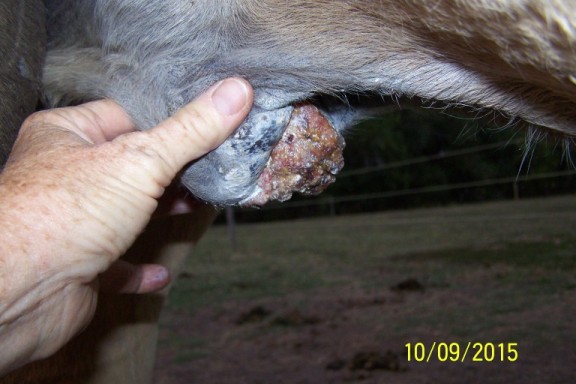 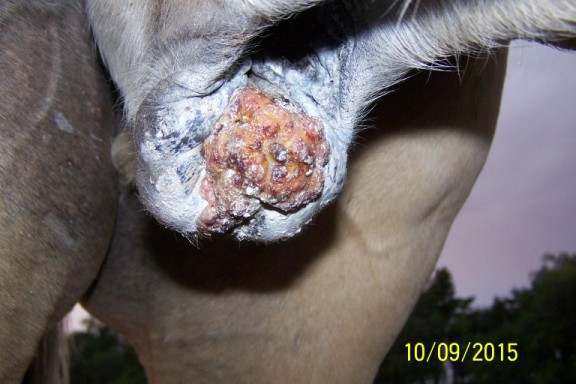 I suspected this summer that he had squamous cell carcinoma, but had to get through the other issues (especially the trailer issue) first. The day came, about 8 months later, when I could finally consider trailering him to OSU Veterinary Teaching Hospital for treatment and surgery. Photos 2 days after the surgery which involved both excising lesions (including a partial, about 2 inches, phallectomy) and using laser on them. 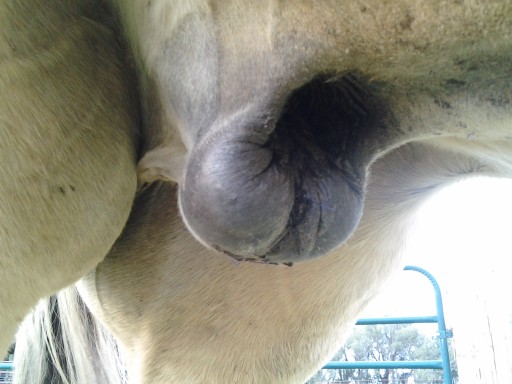 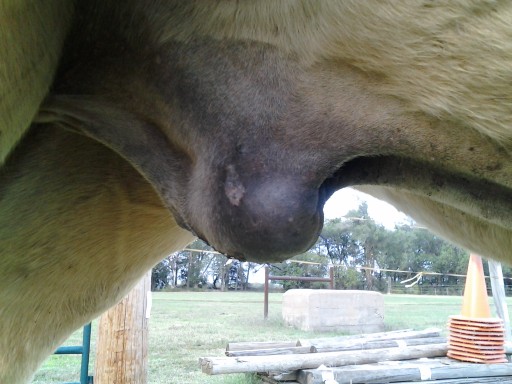 A month later, on a Friday, just before Thanksgiving, I saw something stuck to his sheath. My initial thought was "mud," since we had gotten a good amount of rain, and the paddocks were sloshy, but the next day the "thing" was still stuck to his sheath, so, I looked under him and my heart sank.  What I thought was mud was actually a scab. What I thought was mud was actually a scab. 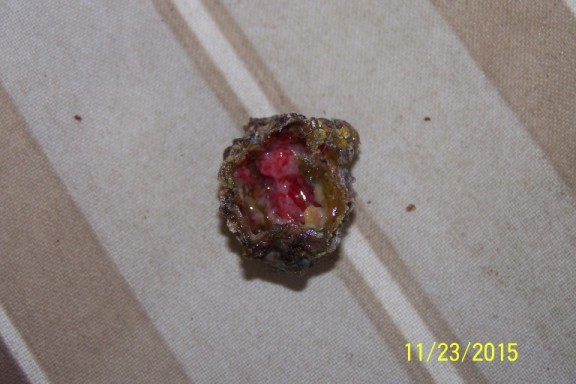 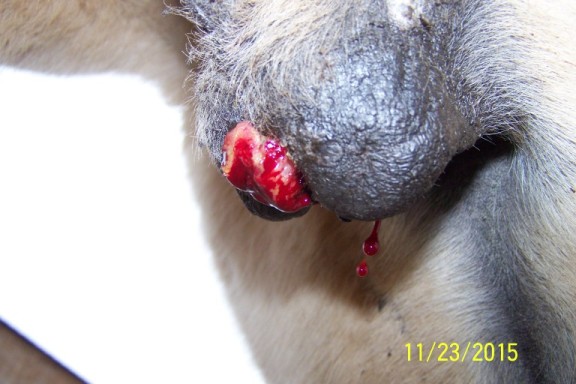 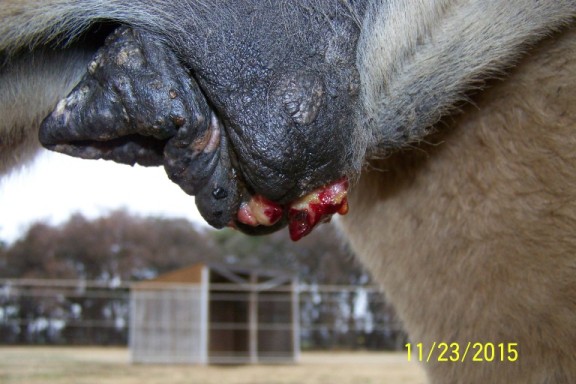 I sent photos to the vet who had done the surgery at OSU, and he had me come in Monday of Thanksgiving week. Sure enough, the cancer had returned, but this time they didn't have to excise, but could just use the laser and leave him standing for the procedure . . . and the vet offered the option of implanting "chemo beads" around the sites of the lesions, with a follow-up implantation a month later, on December 29th, and thought that the chemo might arrest or eradicate the cancer which lab tests showed had migrated to the lymph system. 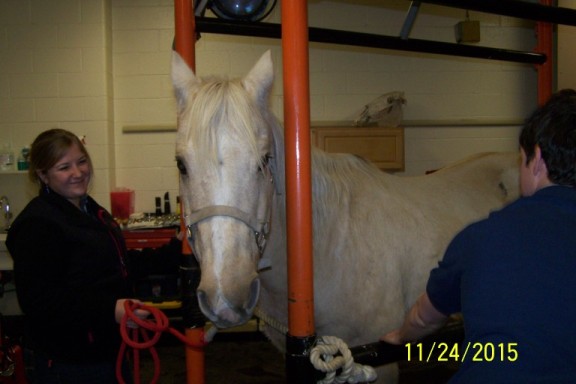 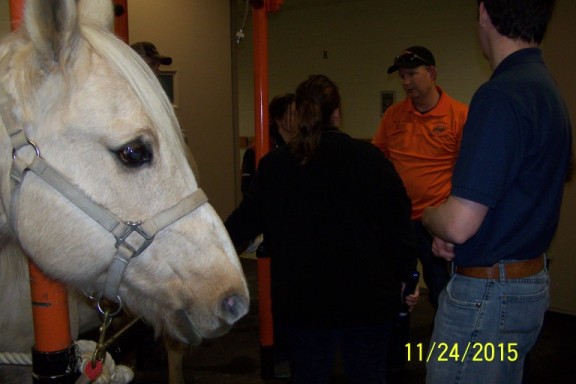 Shiloh was left at OSU for 2 nights, and I picked him up on the day before Thanksgiving. Here is a photo of the sheath after the beads were implanted. His sheath was silver from whatever is sprayed after the beads are implanted. (Dr. O., do you know what is used? I forgot to ask when I was at OSU.) 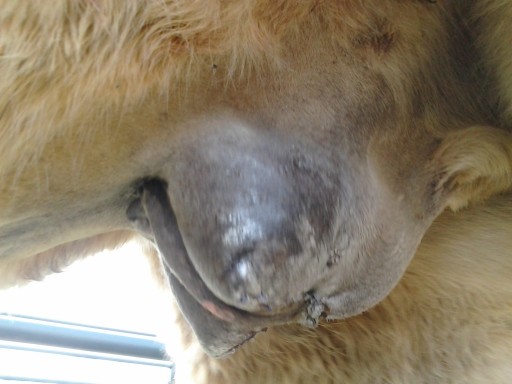 The vet said that there was plenty of tissue around the second lesions to do a good amount of removal, and is encouraging about the ability of the "chemo beads" to kill any cancer in the area. If the gelding hadn't been so young, I might not have gone to the expense, but . . . I really bonded with this fellow and liked him as soon as I went to pick him up . . . some horses are worth it. 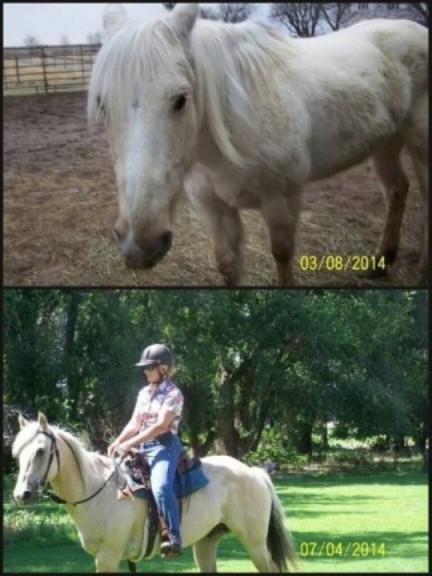 I hope the cancer doesn't return, but if anything changes, I will update. He has had no ill-effects from any of the surgeries, anesthetics, etc., and we have had several opportunities to practice trailering. 
|
| Member: dres |
Posted on Tuesday, Jan 20, 2015 - 2:39 pm: Holly i hope Shiloh does well this time around too ...and be done with it all ..On the first day God created horses, on the second day he painted them with spots .. |
| New Member: moxshi |
Posted on Tuesday, Jan 20, 2015 - 3:21 pm: Ann, thank you. Me, too. Each horse teaches us something new, and health issues are no different. I dealt with SCC years ago with a little Arabian gelding, but his growths were easily lasered and never came back. This was different as it was much more involved, and I am hoping it won't come back this time, either. |
| Moderator: DrO |
Posted on Friday, Jan 23, 2015 - 7:13 pm: Hello Holly,I would guess Cisplatin (a platinum product) seeds as you describe it as chemotherapy but there are also radioactive beads available. There is probably a world of anticancer meds of which I am not aware. DrO |
| Member: moxshi |
Posted on Friday, Jan 23, 2015 - 8:34 pm: Thank you, Dr. O.I was wondering what the silver paint was that was sprayed on Shiloh's sheath after both cisplatin bead treatments. In looking for the information, I found this which explains many of the options of treating SCC and reasons for using them: https://onlinelibrary.wiley.com/doi/10.1111/j.2042-3292.2012.00457.x/full The vet recommended 2 treatments one month apart. The first treatment involved the implantation of 15 beads, I think . . . and the second involved the implantation of only 5, which I didn't understand. The article in the link I posted recommends 3 implantations one month apart. I have written to the vet who did the first surgery and implantation to ask him why they opted to do only 2 with Shiloh and why the second treatment involved so many less beads. |
| Moderator: DrO |
Posted on Friday, Jan 30, 2015 - 5:10 pm: Hello Holly,There are quite a few wound sprays that are silver colored, some actually contain silver others aluminum. The article is good reference and yes you will need to ask the vet for the rationale behind his treatment protocol. DrO |
| Member: paul303 |
Posted on Thursday, Feb 19, 2015 - 9:27 pm: Holly, is there any chance that you could give an idea of the cost of this kind of treatment? |
| Member: moxshi |
Posted on Friday, Feb 20, 2015 - 1:08 am: Hi,Lee!I don't have the bills here at home with me . . . everything is at the tax preparer's right now, but with the exam and first surgery (which was "on his back" with 3 days of boarding/care), the second laser surgery and cisplatin beads (which was done standing and had one overnight), and the second implantation of cisplatin beads, I think it came to over $2000. That's not counting the fuel to drive down to Stillwater and back (just over an hour and 1/2 one way). I'm sure prices vary from vet to vet, and from what I understand, a veterinary teaching hospital can do the procedures at a more affordable cost than a private vet practice, but I'm not sure about that. |
| Moderator: DrO |
Posted on Saturday, Feb 21, 2015 - 10:49 am: Hello All,As to the cost at veterinary teaching hospitals it is variable and most dependent on state funding of the school. The more the funding the less they need to charge the client but the higher everyone's state taxes are likely to be. DrO |
| Member: paul303 |
Posted on Wednesday, Mar 4, 2015 - 7:53 pm: Thanks so much, Holly and Dr.O!! Over the years, I've had experience at New Bolton in Pa. and Ringoes and Mid Atlantic in N.J. The circumstances were all different, but I can understand the charges better now. I'd like to say that the treatment received at each of these facilities, for my horses, and horses of others that I have trailered there, has been nothing short of remarkable. |
Horseadvice.com
is The Horseman's Advisor
Helping Thousands of Equestrians, Farriers, and Veterinarians Every Day
All rights reserved, © 1997 -
is The Horseman's Advisor
Helping Thousands of Equestrians, Farriers, and Veterinarians Every Day
All rights reserved, © 1997 -
